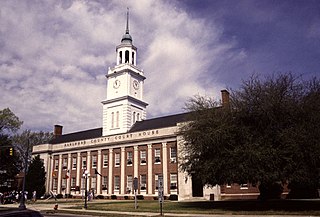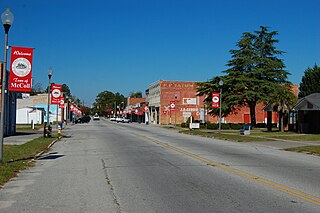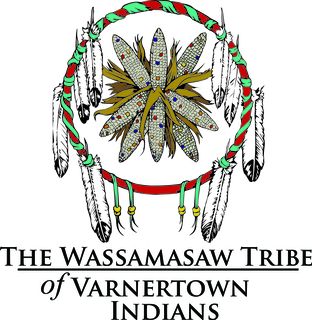
Orangeburg County is a county located in the U.S. state of South Carolina. As of the 2020 census, the population was 84,223. Its county seat is Orangeburg. The county was created in 1769.

Marlboro County is a county located in the Pee Dee region on the northern border of the U.S. state of South Carolina. As of the 2020 census, its population was 26,667. Its county seat is Bennettsville. The Great Pee Dee River runs through it.

McColl is a town in Marlboro County, South Carolina, United States. It lies in the state's Pee Dee region, 8 miles (13 km) from the North Carolina border. The population was 2,174 at the 2010 census.
The Pee Dee is a region in the northeast corner of the U.S. state of South Carolina. It lies along the lower watershed of the Pee Dee River, which was named after the Pee Dee, an Indigenous tribe historically inhabiting the region.
The Lumbee are a Native American people primarily centered in Robeson, Hoke, Cumberland, and Scotland counties in North Carolina.
The Waccamaw people were an Indigenous people of the Southeastern Woodlands, who lived in villages along the Waccamaw and Pee Dee rivers in North and South Carolina in the 18th century.

The Occaneechi Band of the Saponi Nation is a state-recognized tribe in North Carolina.
State-recognized tribes in the United States are organizations that identify as Native American tribes or heritage groups that do not meet the criteria for federally recognized Indian tribes but have been recognized by a process established under assorted state government laws for varying purposes or by governor's executive orders. State recognition does not dictate whether or not they are recognized as Native American tribes by continually existing tribal nations.

The Saponi are a Native American tribe historically based in the Piedmont of North Carolina and Virginia. They spoke a Siouan language, related to the languages of the Tutelo, Biloxi, and Ofo.

The Pedee people, also Pee Dee and Peedee, were a historic Native American tribe of the Southeastern United States. Historically, their population has been concentrated in the Piedmont of present-day South Carolina. It is believed that in the 17th and 18th centuries, English colonists named the Pee Dee River and the Pee Dee region of South Carolina for the tribe. Today three state-recognized tribes, one state-recognized group, and several unrecognized groups claim descent from the historic Pedee people. Presently none of these organizations are recognized by the Bureau of Indian Affairs, with the Catawba Indian Nation being the only federally recognized tribe within South Carolina.

The Wassamasaw Tribe of Varnertown Indians or Wassamasaw Tribe is a state-recognized tribe and 501(c)(3) nonprofit organization headquartered in Berkeley County, South Carolina. The organization was awarded the status of a state-recognized tribe by the South Carolina Commission of Minority Affairs in November 2009, becoming the sixth state-recognized tribe within South Carolina. The Tribe is not federally recognized as a Native American tribe by the Bureau of Indian Affairs. The Catawba Indian Nation is the only Tribe in South Carolina that is federally recognized by the U.S. Government.

The Chaloklowa Chickasaw Indian People or Chaloklowa Chickasaw is a 501(c)(3) nonprofit organization and "state-recognized group" not to be confused with a state-recognized tribe. The state of South Carolina gave them the state-recognized group and special interest organization designation under the SC Code Section 1-31-40 (A) (7)(10), Statutory Authority Chapter 139 (100-111) in 2005.

Waccamaw Siouan Indians are one of eight state-recognized tribes in North Carolina. They are also known as the "People of the Fallen Star." Historically Siouan-speaking, they are located predominantly in the southeastern North Carolina counties of Bladen and Columbus. Their congressional representative introduced a failed bill for federal recognition in 1948. North Carolina recognized the group in 1971.

Town Creek Indian Mound is a prehistoric Native American archaeological site located near present-day Mount Gilead, Montgomery County, North Carolina, in the United States. The site, whose main features are a platform mound with a surrounding village and wooden defensive palisade, was built by the Pee Dee, a South Appalachian Mississippian culture people that developed in the region as early as 980 CE. They thrived in the Pee Dee River region of North and South Carolina during the Pre-Columbian era. The Town Creek site was an important ceremonial site occupied from about 1150—1400 CE. It was abandoned for unknown reasons. It is the only ceremonial mound and village center of the Pee Dee located within North Carolina.

The Coharie Intra-tribal Council, Inc. is a state-recognized tribe in North Carolina. The headquarters are in Clinton, North Carolina.

The Eastern Cherokee, Southern Iroquois and United Tribes of South Carolina, Inc. or ECSIUT is a 501(c)(3) nonprofit organization and "state-recognized group and special interest organization," not to be confused with a state-recognized tribe.

The Waccamaw Indian People is a state-recognized tribe and 501(c)(3) nonprofit organization headquartered in Conway, South Carolina. The organization was awarded the status of a state-recognized tribe by the South Carolina Commission of Minority Affairs on February 17, 2005 and holds the distinction of being the first state-recognized tribe within South Carolina. The Waccamaw Indian People are not federally recognized as a Native American tribe and are one of two organizations that allege to be descended from the historic Waccamaw, the other being the Waccamaw Siouan Indians, a state-recognized tribe in North Carolina. The two organizations are not affiliated with one another.

The Natchez Indian Tribe of South Carolina or Eastern Band of Natchez is a nonprofit organization and "state-recognized group" not to be confused with a state-recognized tribe. The state of South Carolina gave them the state-recognized group and special interest organization designation under the SC Code Section 1-31-40 (A) (7)(10), Statutory Authority Chapter 139 (100-111) in 2007.

Vernon M. Tanner, also known as Mingo Big Bear Claw, was the leader of the Chaloklowa Chickasaw Indian People, a state-recognized "group" in South Carolina. Tanner was formally recognized by the South Carolina General Assembly in 2004 for his significant contributions to the state's Native American affairs, particularly for his role in the development of regulations for the recognition of Native American entities. This acknowledgment included his appointment as the first Native American Commissioner for the South Carolina Commission for Minority Affairs in modern history, a milestone in the state's efforts to include diverse representations within its governmental structure. However, this achievement was soon overshadowed by controversy when it was discovered that the indigenous ancestry claimed by Tanner and the Chaloklowa Chickasaw was incorrect upon the SCCMA's rereview of the organization's petition for recognition as a state-recognized tribe.
















